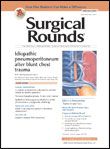When a Child's Abdominal Pain Indicates Appendicitis
Two pediatric surgeons describe a stepwise approach to treating children whose abdominal pain goes beyond a minor problem.

When children develop abdominal pain, it’s usually the result of a minor issue like influenza, constipation, or a secret desire to stay home from school. But on occasion, a child’s abdominal pain is due to a serious pathology, and sometimes, it calls for surgery.
Two pediatric surgeons from King’s College Hospital in London recently published a review describing a stepwise approach to treating children whose abdominal pain goes beyond a minor problem. While they affirmed that a significant number of children have non-specific abdominal pain (NSAP) with no identified cause, they also addressed the very common and life-threatening condition of acute appendicitis.
Researchers still do not know what causes appendicitis, although several theories exist. Localized or generalized peritonitis is a hallmark symptom, depending on whether the inflammation is well contained. Clinicians start a medical history by determining pain onset, character, and severity, and then look for common symptoms, especially the triad of abdominal pain, vomiting, and fever.
The authors described the signs related to appendicitis, including pain on movement, low-grade fever, bounding pulse, and furred tongue. Their handy chart lists differential diagnoses by age, and they also discussed different imaging techniques and their strengths and limitations with regard to diagnosis.
Preceded by prophylactic antibiotics and fluids, surgery is the standard treatment for appendicitis. Historically, appendicitis was considered to be an emergency, so the patient was immediately whisked to the emergency room for surgery. Today, open or laparoscopic surgery is usually delayed until broad-spectrum antibiotics and fluids improve the patient’s condition. Additionally, surgery is usually deferred to usual operating hours in order to stabilize patient.
The authors recommended active observation and continuing investigation if a specific diagnosis is elusive. Since appendicitis is an evolving process, some patients with abdominal pain are ultimately diagnosed with the condition, though others are never diagnosed.
